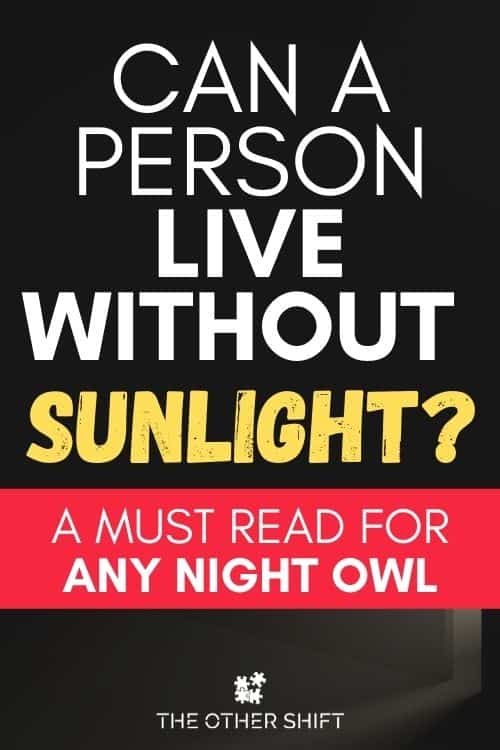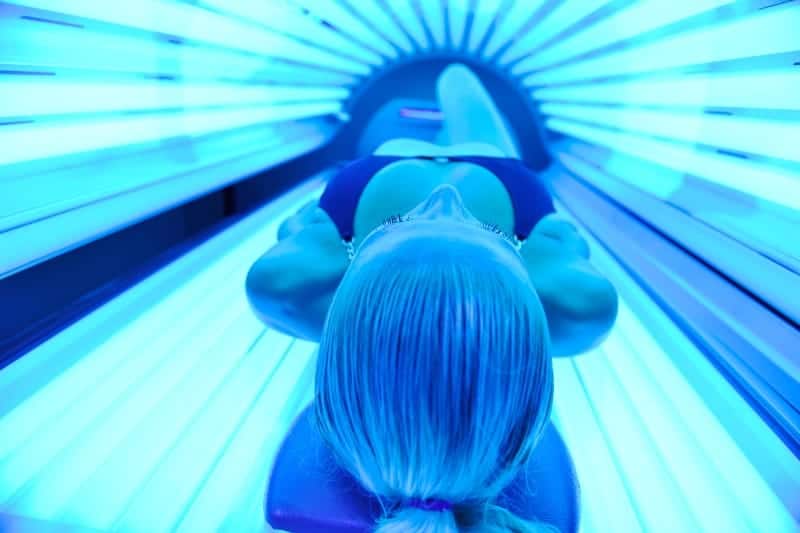Disclosure: This page may contain affiliate links, meaning we receive a commission if you decide to make a purchase through our links, but this is at no additional cost to you. Please read our disclosure and privacy statement for more info.
We wear sunglasses to shield our eyes from it, lather sunscreen to protect our skin from it, and use the heaviest, darkest blackout curtains we can find to block it out to sleep after a long, grueling overnight shift. There are several reasons someone may want, or need to exist in darkness, but can a person live without sunlight?
A person can live without sunlight, though it’s not recommended. Medical experts suggest 10-15 minutes of sun exposure each day though this varies on geographical location. Deficiency can lead to a lack of Vitamin D, contributing to mood disorders, weaker bones and trouble sleeping.

There are circumstances where a person may be forced to spend a majority of their time in the dark; medical conditions, job schedules and living locations can make it difficult for certain people to access sunlight. In those scenarios Vitamin D supplements or artificial light, along with a healthy diet and exercise, can help fend off, or at the very least minimize negative impacts from a lack of natural light.
Sunlight & Our Bodies
To answer if someone can live without sunlight, we first need to look at why our bodies need it in the first place. We tend to focus on the surface-level risks associated with too much sun exposure. Issues like eye damage, sunburn, heat rash, skin cancer and wrinkles can typically be prevented or treated easily.
However, the Centers for Disease Control and Prevention is clear that heat stress related illnesses like heat stroke and heat exhaustion can be incredibly dangerous, even deadly if immediate action is not taken. Heat stroke is the most serious of them all with symptoms that include:
- Confusion, altered mental status, slurred speech
- Loss of consciousness (coma)
- Hot, dry skin or profuse sweating
- Seizures
- Very high body temperature
- Fatal if treatment delayed
If you or someone you know start experiencing these effects, call the authorities right away to seek emergency medical care.
The risks of too much sunlight are important to keep in mind, but so are the risks of not getting enough.
Medical centers like this one are quick to point out the benefits of sun exposure, in moderation, for both body and mind. A lot of the good stuff surrounding sunlight comes from Vitamin D. Vitamin D does a LOT for our bodies and the sun is the best natural source of it.
Here are some of the ways Vitamin D and the sun can give your body a boost, but there’s also plenty more:
- Promotes reduced inflammation and cell growth
- Boosts serotonin levels and enhances mood
- Treat Seasonal Affective Disorder
- Improve sleep
- Relieve stress
- Lower blood pressure
- Improve heart health
- Boost brain function
- Strengthen bones through calcium absorption
[VIDEO] – On our YouTube channel you’ll find this video which walks you through 5 things you should think about when working multiple nights in a row… and without wanting to ruin the surprise, getting sunlight is one of them!
How Much Sunlight Do We Need? And When Should We Get It?
While many of us will try to avoid the sun right smack in the middle of the day, when it’s at its highest point in the sky, research suggests that’s actually the best time to catch some rays.
Experts say aim for the hours between 10:00am and 1:00pm, as that’s apparently when our skin will produce the best amount of Vitamin D, but as is the case with so many other things, moderation (and safety) are key here.
“Spending even a short time in the sun can provide the body with all of the Vitamin D it needs for the day.”
Even just 10-15 minutes of time in the sun can help your body access the benefits of Vitamin D. It can also be enough to help your body maintain its natural circadian rhythm.
Here is a link to a quick video explaining what our circadian rhythm is, why it’s important and the role sunlight plays in regulating the whole thing: Circadian Rhythm and Your Brain’s Clock
In short, that biological rhythm follows the cycle of the sun to tell our bodies when we should be awake and when we should sleep. If you are living without daylight, the wheels could very well come right off!

Living Without Sunlight
Even with the potential risk, there are some people who wind up spending most of their time without sunlight. For people with medical conditions, it’s often a necessity.
This article offers a firsthand account of a gentleman who was diagnosed as photosensitive, and has therefore essentially lived in darkness for more than a decade.
“Photosensitivity is heightened skin sensitivity or an unusual reaction when your skin is exposed to UV radiation from sunlight or a tanning bed. You can become photosensitive as a result of prescription or over-the-counter medications, a medical condition or genetic disorder, or even by using certain types of skin care products.”
The Skin Cancer Foundation
Symptoms of photosensitivity can range from a rash similar to a sunburn, to an all-out immune system response that causes blistering and lesions on the affected skin. In more severe sensitivities, like something called Xeroderma Pigmentosum, even UV rays from a lightbulb can be enough to damage the skin. People living with these conditions are advised to avoid sunlight as much as possible and to cover up and apply sunscreen if they have no other choice but to go outdoors.
Shift work is another factor driving people to avoid sunlight. A lot of times, it’s because they are trying to go to bed! The Cleveland Clinic estimates about 20 percent of the US workforce is involved in some form of shift work, or a schedule outside of the typical 9am to 5pm.
For those on the overnight shift especially, that key period of time we mentioned earlier, between 10am and 1:00pm to get Vitamin D from the sun, can also be prime sleep time. That ongoing battle against the elements in the name of sleep, can leave this group especially susceptible to increased fatigue, moodiness, brain fog, and a host of other negative physical and mental side effects.
For night shift workers, utilize your days off outside rather than sitting indoors and enjoying some afternoon sunshine before heading off for a shift (though potentially low in UV rays) are simple strategies to consider.
Geography can also play a big role in how much sunlight a person can access.
Take Alaska for instance. The further north you go, the darker it gets during winter. Those who live in Fairbanks, Alaska, will only get access to 3 hours and 41 minutes of sunlight on the shortest day of the year (December 21). Doesn’t leave you with much time to get a suntan!
Even people living across the U.S. can be at risk of Vitamin D deficiency based on where they live. Harvard Medical School published this article on this very topic and includes a map showing which states are at higher risk of deficiencies outside of the summer months. It expands a much larger region than you might think!

Impact of Living Without Sunlight
As we touched on earlier, living totally in the dark is not recommended and extended periods of time without sunlight can lead to a host of negative side effects. Once again, a lack of Vitamin D is at the center of the concerns here.
Here is a quick video detailing what would happen if you never saw the sun. What Would Happen If You Never Saw The Sun?
Mood disorders, weaker bones, higher blood pressure, trouble sleeping, even an increased risk for OCD can all result from spending too little time in the sun. Plus, when you consider it can be hard to get the recommended daily amount of Vitamin D from supplements or food, it’s an extra incentive to aim for that 10-15 minutes in the midday sun that experts recommend.
Sunlight Alternatives
With Vitamin D being one of the main benefits of sunlight exposure, supplements are available for those who can’t get it naturally by going outdoors.
In 2011, the Institute of Medicine upped its recommendations to 600 IU for people up to age 70 and to 800 IU for those over 70.
Again, however, moderation is key here as the Mayo Clinic points out. Too much Vitamin D can also have negative side effects:
Children age 9 years and older, adults, and pregnant and breastfeeding women who take more than 4,000 IU a day of vitamin D might experience:
- Nausea and vomiting
- Poor appetite and weight loss
- Constipation
- Weakness
- Confusion and disorientation
- Heart rhythm problems
- Kidney stones and kidney damage

If supplements don’t sound appealing, there are certain foods that can also provide a decent amount of Vitamin D.
- Salmon
- Herring and sardines
- Cod liver oil
- Canned tuna
- Egg yolks
- Mushrooms
- Fortified foods
If gadgets are more your style, you may want to consider a sun lamp or light therapy box. This type of light therapy will not always help produce Vitamin D, but research shows it can help improve mood and fight seasonal depression.
“It’s common to see improvement in your mood within two to four days if you use a 10,000 lux bulb for about 30 minutes every morning.” (source)
Be warned though, this method is not recommended for everyone. Doctors with Cleveland Clinic warn anyone with the following conditions should consult with their personal physician before using any sort of sun lamp or light therapy box:
- Macular degeneration
- Connective tissue damage
- Existing skin cancers
- Diabetes
- Lupus
- Bipolar Disorder
Can Tanning Beds Provide Vitamin D?
One method of artificial light we want to mention is the tanning bed. When we first moved to the United States, we were surprised as to how many locations we came across offering a place to turn ourselves golden. The local gym had a members-only section where this was a big perk – 6 beds in one location!
Australia had made it illegal to operate a tanning salon, so this was a big difference from what we were accustomed too. So as shift workers, we did our research to find out if this could help with a lack of Vitamin D.
The American Academy of Dermatology Association says getting enough Vitamin D from a tanning bed simply is not possible because – “The bulbs used in tanning beds emit mostly UVA light; however, your body needs UVB light to make vitamin D.” Therefore, the potential risks for skin or eye damage in a tanning bed far outweigh the benefits for many board-certified dermatologists. So we recommend to steer clear.

Can You Live Without Sunlight Forever?
The question of “Can you live without sunlight forever?” may be better posed as, “SHOULD you live without sunlight forever?”… The short answer is… NO.
There are many potential side effects associated with a total lack of sunlight, but research seems to suggest it is physically possible to go without it, given the right dietary practices.
In 2012, a Russian cult living underground was discovered and questions swirled about its members, many of whom had lived in total darkness their entire lives. Below is a snippet from an article written shortly after, looking to answer the question of “Can you live without sunlight?”
“Recent research suggests that sunlight deprivation might increase susceptibility to a wide range of chronic diseases, such as diabetes and high blood pressure, as well as infectious diseases like tuberculosis and the common cold. But it’s very unlikely that an adult could die directly and exclusively from prolonged darkness.
The most plausible deadly scenario is that a lack of sunlight could prevent the body from producing vitamin D, which, in turn, would inhibit calcium absorption. Very low calcium levels might lead to spasms of the larynx, causing suffocation.
A proper diet, however, can easily stave off this unlikely chain of events and other health consequences, even if you live in a bunker. Vitamin D is present in egg yolks, cheese, fatty fish, and fortified milk, juice and cereal.” (source)
If that wasn’t heavy enough reading for you, here’s a summary of what could happen if the sun disappeared altogether! But we’ll save going into that detail here for another time…
We hope this article answered our questions regarding a lack of sunlight and how you can go about getting your recommended does of Vitamin D. Outside of factors that are out of your control, make a concerted effort to get outside in the sun for around 15 minutes each day, but do so responsibly. Your body will thank you for it without even knowing!
Cheers,

Disclosure: This page may contain affiliate links, meaning we receive a commission if you decide to make a purchase through our links, but this is at no additional cost to you. Please read our disclosure and privacy statement for more info.
Recent Posts
While the stresses and hardships of work affect all, signs point to significant pressures faced by those working through the night leading to early critical health problems. But is it all doom...
Switching your days and nights around might be easy in your twenties, simply pull an all-nighter and crash. Problem solved. If you’ve been on midnights for ten or more years though, the adjustment...

